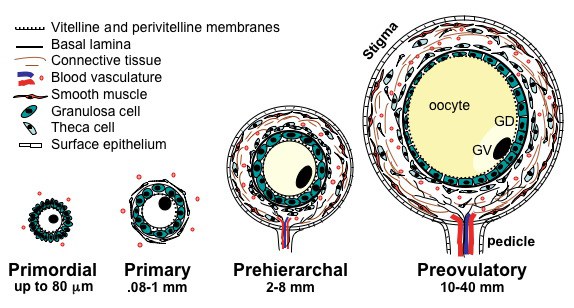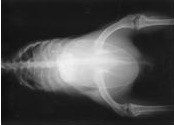Growth and Development of Follicles in the Avian Ovary
The process of follicle growth can be conveniently divided into: 1) the organization of primordial follicles and the early growth of primary follicles, the latter of which may persist for years; 2) the recruitment of primary follicles into the slow growth phase (the prehierarchal or previtellogenic stage) lasting weeks to perhaps months; 3) selection of a single follicle into the preovulatory hierarchy; and 4) the subsequent rapid growth of preovulatory follicles which occurs during the final days preceding ovulation. The continued viability and development of ovarian follicles within a breeding season is critically dependent upon endocrine factors (e.g., gonadotropins) circulated by the blood, paracrine and autocrine factors produced within the ovary itself, plus neurochemical and neurohumoral factors expressed by the nervous system.

Organization of domestic hen ovarian follicles during development. Primary oocytes enclosed by the vitelline membrane become organized into a primordial follicle (up to ~80 m diameter) following the recruitment of presumptive granulosa cells, and the perivitelline membrane is subsequently formed by granulosa cells. The initiation of primordial follicle growth to the primary follicle stage is associated with the formation of the theca layer (from mesenchymal cells), which is separated from the granulosa layer by the basal lamina. Primary follicles range in size from .08 to 1 mm in diameter. Further growth to the prehierarchal follicle stage (1-8 mm) entails the accumulation of lipoprotein-rich, white yolk, plus the differentiation of the theca into interna and externa layers. Vasculature and nervous innervation reaches the follicle through the pedicle and radiates through the theca layer. Following selection into the preovulatory hierarchy, preovulatory follicles rapidly grow from 9 mm to 40 mm over the course of days. Granulosa cells from preovulatory follicles facilitate the uptake of large amounts of vitellogenin and very low density lipoprotein, except within the germinal disc region. Ovulation of the largest preovulatory follicle eventually occurs at the region of the comparatively avascular stigma region. For additional details, see Johnson and Woods, 2007.
Avian Ovary Asymmetry
During embryonic development, the left and right ovaries are presumably present in all birds, but in many species only a functional left ovary is maintained post-hatch. By comparison, some species commonly maintain both gonads (e.g., a number of falcons, eagles, vultures and the kiwi [Apteryx spp.]). The kiwi (adult body weight of ~2.2 kg) has one of the largest egg-to-body ratios (1:5) amongst all birds, with an estimated 75 to 88 mm diameter yolk size attained immediately prior to ovulation (Jensen and Durrant, 2006, Zoo Biology 25:25-34).

Ultrasound scan of a calcified brown kiwi (Apteryx mantelli) egg within the shell gland immediately prior to oviposition. Image is courtesy of Dr. Tom Jensen, Center for Reproduction of Endangered Species, Zoological Society of San Diego, San Diego, CA.

